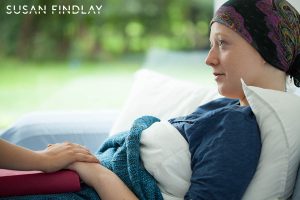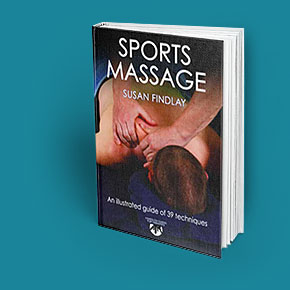This is a question I get asked by therapists, clients, medical professionals and even by those who are well versed in the benefits of soft tissue therapy. In my experience, what makes it different from other types of massage is the disease and the clients’ state of health. Like other conditions that affect the tissue and the physiology of the body’s systems, therapists will need to modify their techniques, the positioning, the duration of the session, the depth, speed and the area in which a therapist can work. A massage therapist will also need to consider the type, the location and the effect of both the disease and treatment. The biggest difference, however, is the actual application of the massage.
 Oncology massage is neither light, fluffy or insubstantial, it addresses the needs of the client and how the tissue responds, the most descriptive word I use when teaching this method is to feel what is happening underneath your hands, to be led by the tissue and respond to it, not force your way through in an unthinking way, but to ‘melt’ into the soft tissue in a considered way. This form of massage is not exclusive to Oncology but it is less demanding on those who are suffering with cancer or any condition that is placing a greater stress on the body’s systems, the intention of this approach is to assist the client’s recovery rather than causing them to recover from the massage.
Oncology massage is neither light, fluffy or insubstantial, it addresses the needs of the client and how the tissue responds, the most descriptive word I use when teaching this method is to feel what is happening underneath your hands, to be led by the tissue and respond to it, not force your way through in an unthinking way, but to ‘melt’ into the soft tissue in a considered way. This form of massage is not exclusive to Oncology but it is less demanding on those who are suffering with cancer or any condition that is placing a greater stress on the body’s systems, the intention of this approach is to assist the client’s recovery rather than causing them to recover from the massage.
This approach to Oncology massage is in fitting with my “less is more” ethos when it comes to using force, which I apply to all of my patients. I take great umbrage with the school of thought that massage should be a painful experience, both in the application and recovery phase. I firmly believe that one of the most important aspects of my practise is encouraging people to listen to the messages their body is telling them; if the body is sending pain messages following a massage then this would indicate that it has been damaged. Pain does not equate to healing in my book, and you do not have to use brute force to increase blood flow to an area. Of course, this is especially true for Oncology massage. Cancer can have many symptoms, of which pain is one of them, and I certainly don’t want to be adding to this.
 My desired outcome for this form of massage is to leave the patient feeling relieved. Whilst there are numerous physical benefits of massage, there are just as many for mental health.
My desired outcome for this form of massage is to leave the patient feeling relieved. Whilst there are numerous physical benefits of massage, there are just as many for mental health.
Cancer can be very tough emotionally, with patients having to cope with feelings of uncertainty and anxiety. As a practitioner, I also need to constantly be mindful of the body as a whole; I could not consider myself holistic if I did not.
This mean that I have to be aware of the fact that the body is not just a mass of solitary organs, nerves, bones, and muscles which do one job and do not communicate or relate to each other. The body is a finely balanced ‘machine’ with parts that interact; if one of these is thrown off balance then it will have a knock-on effect. This means that any physical malfunction can impact on our mental state. When performing Oncology massage we must be aware of this fact, and we must also educate ourselves on the potential mental health impact the diagnosis may entail.
 A cancer diagnosis can be extremely traumatic; patients are often suddenly faced with their own mortality, and an uncertain future. Even the word “cancer” is emotionally loaded; most people have known someone who has suffered from this disease so even a potential diagnosis can trigger a traumatic response. This is all before a patient has begun treatment, which can be extremely invasive and comes with a myriad of side effects. These all have the potential to be traumatic to the patient.
A cancer diagnosis can be extremely traumatic; patients are often suddenly faced with their own mortality, and an uncertain future. Even the word “cancer” is emotionally loaded; most people have known someone who has suffered from this disease so even a potential diagnosis can trigger a traumatic response. This is all before a patient has begun treatment, which can be extremely invasive and comes with a myriad of side effects. These all have the potential to be traumatic to the patient.
I believe that in order to be a successful holistic practitioner one must be aware of the impact on which trauma has on the body. To clarify this, I do not mean successful in terms of financial gain. I mean successful in terms of giving patients relief from symptoms; this is always my number one priority. We can increase our ability to do this by being trauma informed; we must be aware of how trauma manifests within the body. If you want to educate yourself further on this then fantastic books to read are “The Body Keeps the Score” by trauma expert Bessel van der Kolk and “Waking the Tiger” by Peter Levine.
Cancer and its treatment can be incredibly stressful. Stress causes our bodies to release adrenaline, which causes our muscles to tense up, in readiness to respond to a situation or experience. Prolonged stress causes tissue to suffer negative symptoms such as tension, weakness, lack of energy etc. On a purely physical level, massage helps to change the physiological environment which in turn helps the tissue to relax.
However, the stress-relieving properties of massage does not end with the physical. It has been shown that massage stimulates the Vagal nerve, part of our parasympathetic nervous system which sends a message throughout the body telling it to destress. Reflexology (foot massage) is shown to increase stimulation of this nerve (1), as has massaging the carotid sinus, which is located on the right side of your throat (2). Researchers in Japan proved that massage which activates this system can also boost the recipient’s overall mood (3); which is obviously beneficial for any Oncology patient.
Insomnia is a common complaint amongst Oncology patients; some may stay awake due to the anxiety their diagnosis brings, whilst others may be kept up by the side-effects of the drugs they receive. Sleep deprivation is linked to a lowered immune system; keeping this at an optimum level is incredibly important for everyone, but especially important for those who may have a weakened immune system from chemotherapy. Massage has been shown to improve both sleep quality and serotonin levels in recipients (4). These increased levels are also associated with a feeling of calm and ease of falling asleep.
 In my approach to Oncology massage I always aim to approach it from a whole-body perspective. This means that I do not shy away from referring patients to other practitioners should I deem it beneficial; this means that often my patients end up seeing Pilates instructors, nutritionists, or osteopaths, to name but a few. Again, my personal enrichment is not the primary motivation here; it is the wellness of my clients.
In my approach to Oncology massage I always aim to approach it from a whole-body perspective. This means that I do not shy away from referring patients to other practitioners should I deem it beneficial; this means that often my patients end up seeing Pilates instructors, nutritionists, or osteopaths, to name but a few. Again, my personal enrichment is not the primary motivation here; it is the wellness of my clients.
If you are looking for a Certified Oncology Massage Therapist, you can email me at info@susanfindlay.co.uk. I will post your request in our private Facebook group to see if I can match you up with a suitable therapist. If you are looking to train as an Oncology Therapist, join me on one of the upcoming oncology courses, your touch can make a real difference in someone’s life.
References
- Lu WA, Chen GY, Kuo CD. Foot reflexology can increase vagal modulation, decrease sympathetic modulation, and lower blood pressure in healthy subjects and patients with coronary artery disease. Altern Ther Health Med. 2011;17(4):8-14.
- Field, Tiffany et al. “Potential underlying mechanisms for greater weight gain in massaged preterm infants.” Infant behavior & development vol. 34,3 (2011): 383-9. doi:10.1016/j.infbeh.2010.12.001.
- Hatayama, Tomoko et al. “The Facial Massage Reduced Anxiety And Negative Mood Status, And Increased Sympathetic Nervous Activity”. Biomedical Research, vol 29, no. 6, 2008, pp. 317-320. Biomedical Research Press, doi:10.2220/biomedres.29.317. Accessed 25 Aug 2020.
- Song, Rye Hun, and Do Hwan Kim. “The Effects Of Foot Reflexion Massage On Sleep Disturbance, Depression Disorder, And The Physiological Index Of The Elderly”. Journal Of Korean Academy Of Nursing, vol 36, no. 1, 2006, p. 15. Korean Society Of Nursing Science, doi:10.4040/jkan.2006.36.1.15. Accessed 25 Aug 2020.

